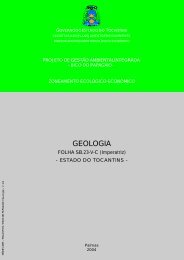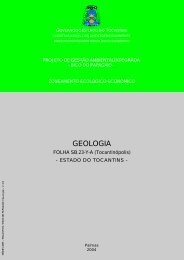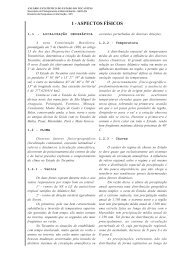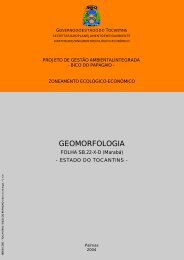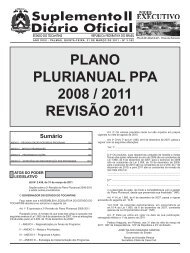GEOMORFOLOGIA - seplan - Governo do Estado do Tocantins
GEOMORFOLOGIA - seplan - Governo do Estado do Tocantins
GEOMORFOLOGIA - seplan - Governo do Estado do Tocantins
You also want an ePaper? Increase the reach of your titles
YUMPU automatically turns print PDFs into web optimized ePapers that Google loves.
Abstract<br />
This report and the Geomorphological map attached are about the study<br />
and cartography of the relief of part of the State of <strong>Tocantins</strong>, Federal Unit of the<br />
Northern Region of Brazil. The mapped area corresponds to portions of the topografic<br />
Sheet SB.22-Z-B Xambioá, previously mapped at scale 1:1.000.000 by<br />
RADAMBRASIL project and existent at scale 1:250.000 in SEPLAN’s archives. The<br />
area is limited at the North by parallel 6º00’00” and at the South by parallel 7º00’00”<br />
of latitude South of Equator, at the West by Araguaia River and the East by Meridien<br />
48º00’00” west of Greenwich. The report presents, under metho<strong>do</strong>logy considerations,<br />
the hierarquical ordering of geomorphological facts, identified trough Landsat-5 imagery.<br />
It discusses the available bibliographie contribution, conparing it to the results<br />
obtamed in the present survey. Based on similarity of relief forms, relative altimetry,<br />
genetic characteristics and watersheds conformation, three Morphostructural Domains<br />
are defined in the area: Bacias Sedimentares Paleo-mesozóicas e Coberturas Meso-<br />
cenozóicas (Paleo-mesozoic and Meso-cenozoic Sedimentary Basins),<br />
Embasamentos em Estilo Complexo e Faixas de Dobramentos (Complex Stile<br />
Basements and Folding Belts), and Azonal das Áreas Aluviais (Azonal from Alluvial<br />
Areas); two Geomorphological Regions: Planaltos da Bacia <strong>do</strong> Parnaiba (Parnaíba<br />
Basin Highlands) and Depressão <strong>do</strong> Araguaia-<strong>Tocantins</strong> (Araguaia-<strong>Tocantins</strong><br />
Depressions); and three Geomorphological Units: Planalto Residual <strong>do</strong> Araguaia<br />
(Highlands Araguaia’s Residual), Depressão <strong>do</strong> Araguaia (Araguaia’s Depression)<br />
and Chapadas <strong>do</strong> Meio-Norte (Middle-North Plateus), besides the Azonal Units<br />
characterizad by Planícies e Terraços Fluviais (Fluvial lowlands and Terraces). It<br />
analyses the different factors that characterize relief evolution. It recognizes several<br />
erosive phases, resulting in the formation of pediment. It refers to the opening of<br />
folded reliefs and to the interference of a recent techtonic movement over drainage<br />
and planed surfaces. It assesses the relief forms and suggets better uses of land. It<br />
analyses road tracing, fluvial navigation, the existense of sites favourable to the<br />
implantation of weirs, hydroeletric power plants and dams for water collection and<br />
suggests plans with the possibility of ocorrence of mineral ores.




